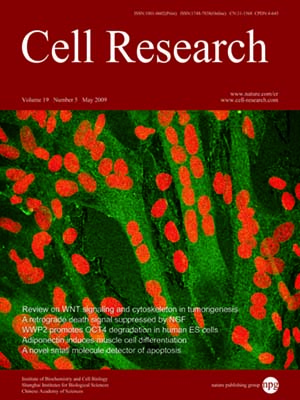
Volume 19, No 5, May 2009
ISSN: 1001-0602
EISSN: 1748-7838 2018
impact factor 17.848*
(Clarivate Analytics, 2019)
Volume 19 Issue 5, May 2009: 574-583
ORIGINAL ARTICLES
Induction of CD4+CD25+Foxp3+ regulatory T cell response by glatiramer acetate in type 1 diabetes
Guoliang Cui1, Yuebo Zhang1, Zhenwei Gong1, Jingwu Z Zhang2 and Ying Qin Zang1
1Key Laboratory of Nutrition and Metabolism, Institute for Nutritional Sciences, Shanghai Institutes for Biological Sciences, Graduate School of CAS, Chinese Academy of Sciences, 319 Yue Yang Road, Shanghai 200031, China
2Institute of Health Sciences, Shanghai Institutes for Biological Sciences, Graduate School of CAS, Chinese Academy of Sciences, 319 Yue Yang Road, Shanghai 200031, China
Correspondence: Ying Qin Zang,(yqin@sibs.ac.cn )
Glatiramer acetate (GA) is an immunomodulatory peptide drug used to treat multiple sclerosis. Its treatment effect has been expanded to other autoimmune conditions such as uveoretinitis, inflammatory bowel disease, graft rejection and hepatic fibrosis. Here, we report that GA was effective in altering the clinical course of diabetes in cyclophosphamide (CY)-potentiated non-obese diabetic (CY-NOD) mice. Treatment with GA significantly reduced the diabetic rate in the mice and ameliorated insulitis, which coincided with increased CD4+CD25+Foxp3+ T cell response in treated mice. GA treatment led to increased expression of transcription factor Foxp3 and elevated production of interleukin-4 (IL-4) both in vivo and in vitro. It was evident that the effect of GA on up-regulation of Foxp3 was mediated partially through IL-4. IL-4 was found to maintain Foxp3 expression and regulatory function of CD4+CD25+ regulatory T cells (Tregs). This study provides new evidence that GA has treatment potential for type 1 diabetes through the induction of Tregs and that increased IL-4 production is partially responsible for the enhanced Treg's function in GA treatment.
Cell Research (2009) 19:574-583. doi: 10.1038/cr.2009.12; published online 3 February 2009
FULL TEXT | PDF
Browse 1972


